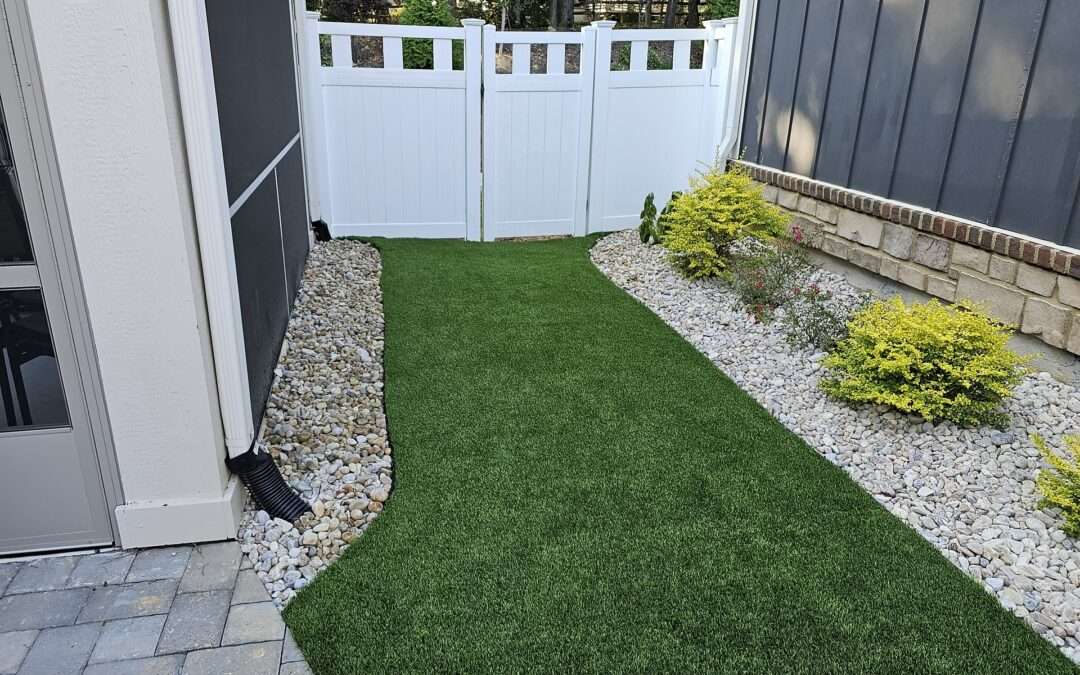For homeowners seeking a lush, green lawn without the hassle of constant maintenance, artificial grass has become an increasingly popular choice. With advances in synthetic turf technology, it now closely resembles natural grass while offering a range of benefits. However, before making the switch, it’s essential to understand both the advantages and potential drawbacks of artificial grass.
The Benefits of Artificial Grass for Homeowners
Low Maintenance
One of the biggest advantages of artificial grass is its minimal upkeep. Unlike natural grass, which requires mowing, watering, fertilizing, and aerating, synthetic turf remains green and vibrant year-round with little effort. Occasional brushing and rinsing help keep it in top condition, making it an attractive option for busy homeowners. This is especially beneficial for those who travel frequently or have limited time for lawn care.
Water Conservation
With growing concerns over water usage, artificial grass offers a sustainable alternative to traditional lawns. Homeowners can significantly reduce their water bills since synthetic turf does not require regular irrigation. According to studies, replacing a natural lawn with artificial grass can save thousands of gallons of water annually, making it an environmentally responsible choice.
Durability and Longevity
High-quality artificial grass can last 15 to 20 years, making it a long-term investment for homeowners. It is designed to withstand heavy foot traffic, pets, and varying weather conditions without becoming patchy or discolored. Additionally, modern artificial grass products come with UV protection to prevent fading and degradation from prolonged sun exposure.
Aesthetically Pleasing Year-Round
Artificial grass maintains its vibrant green appearance throughout the seasons, regardless of temperature fluctuations, shade coverage, or foot traffic. Unlike natural grass, which may struggle in areas with poor soil quality or excessive shade, synthetic turf thrives in any location, making it a great option for homeowners looking to enhance their curb appeal effortlessly.
Pet and Child-Friendly
Many synthetic grass options are designed with safety in mind, providing a soft surface for children and pets to play on. Additionally, artificial grass eliminates the need for chemical treatments like pesticides and fertilizers, creating a safer outdoor environment. Some varieties are even engineered with antimicrobial properties to reduce bacteria and odors caused by pet waste.
Allergy Reduction
For homeowners who suffer from grass allergies, artificial turf can provide relief. Natural grass produces pollen that triggers allergic reactions, but synthetic alternatives eliminate this issue. Additionally, because artificial grass does not require fertilizers or weed killers, it reduces exposure to chemicals that may exacerbate allergies or respiratory conditions.
Potential Drawbacks of Artificial Grass
Initial Installation Cost
While artificial grass saves money on maintenance in the long run, the upfront installation costs can be higher than laying sod. However, this cost is often offset over time through reduced water bills and lawn care expenses.
Heat Retention
Synthetic turf can become hot in direct sunlight, making it uncomfortable to walk on barefoot during peak summer months. However, some manufacturers offer cooling technologies or recommend infill options to help reduce heat buildup. Homeowners can also mitigate heat retention by selecting lighter-colored turf or installing shade structures.
Drainage Considerations
Proper installation is crucial to ensuring adequate drainage. While high-quality artificial turf is designed with efficient drainage systems, poor installation can lead to water pooling or odor retention, especially in pet-friendly yards. Homeowners should work with professional installers to ensure proper grading and drainage solutions.
Environmental Considerations
Although artificial grass conserves water and reduces chemical use, some homeowners have concerns about its recyclability. Choosing eco-friendly turf options made from recyclable materials can help mitigate this issue. Additionally, while synthetic grass eliminates the need for gas-powered lawn equipment, homeowners should consider its end-of-life disposal and opt for products that offer sustainable disposal solutions.
Artificial Feel and Appearance
While modern artificial grass closely resembles natural turf, some homeowners may still prefer the look and feel of real grass. Advances in technology have led to softer, more realistic synthetic turf, but those who enjoy the natural scent and texture of real grass may find artificial options less appealing. Testing samples before installation can help homeowners choose a product that meets their expectations.
Is Artificial Grass Right for You?
Ultimately, the decision to install artificial grass depends on your priorities as a homeowner. If you value a consistently green lawn with minimal upkeep and reduced water use, synthetic turf could be a worthwhile investment. However, it’s essential to consider factors such as budget, climate, and personal preferences before making the switch.
Get Expert Advice from Carolina Turf Systems
At Carolina Turf Systems, we specialize in high-quality artificial grass solutions tailored to meet homeowners’ unique needs. Whether you’re looking for a pet-friendly option, a low-maintenance lawn, or an eco-conscious alternative, our team is here to guide you through the selection and installation process.
Contact us today to explore your options and transform your outdoor space with durable, beautiful synthetic turf!

